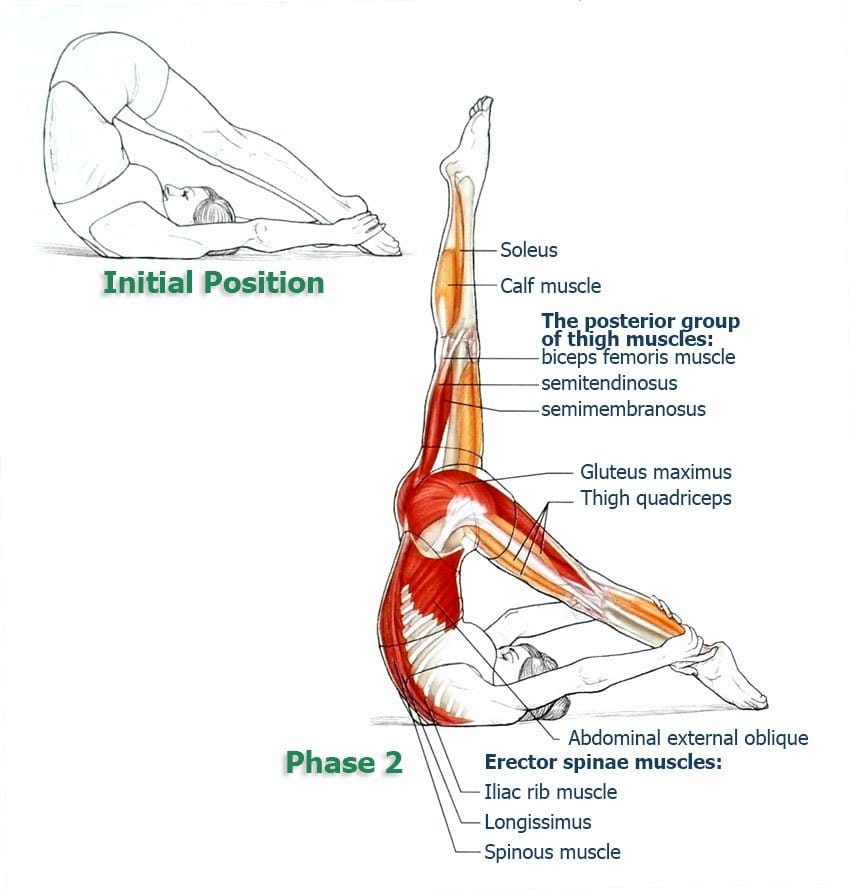Controlled Balance depends upon a mastery of number of difficult exercises we’ve covered previously in the program. You must have an already developed ability to control your body and maintain balance in a difficult position. The exercise requires an interaction between the core muscles of the abdomen and back, as well as muscles in the legs. However, the benefits of Controlled Balance will be obvious, from normal individuals to professional athletes and performers.
The series so far:
- Exercise #1: Rolling Over
- Exercise #2: Seal
- Exercise #3: Crab
- Exercise #4: Rocking Chair
- Exercise #5: Extended Legs Back Roll
- Exercise #6: Boomerang
- Exercise #7: Controlled Balance (you are here)
- Exercise #8: Jackknife
Exercise #7: Controlled Balance

Initial position. Follow Extended Legs Back Roll exercise until you reach the final phase. Your extended toes should touch the mat or come as close as possible to it. Extend your arms behind your head and grab the feet:
- Breathing out, move your hands on the shin/shank of one of the legs, so that one hand is in the area of the ankle and the other covers the gastrocnemius (calf) muscle. Lift the other leg in an upright position;
- Breathing in, let go of the lower leg and return to the initial position of the feet and hands. Repeat the exercise 3 times for each leg. After the last repetition, lower both legs to the mat over your head and gently roll to the starting position of Extended Legs Back Roll.
Make Sure You:
- When the legs in the 1st phase are over the head, tense your abdominal muscles to bend the spine steadily and progressively in the form of the letter “C”. Bring the pelvis towards the shoulders. At the same time engage the back muscles that bend the lumbar area of the spine to reduce the tilt angle of the pelvis and to direct the coccyx vertically upwards. Try to maintain this position of balance when making the leg movements;
- When one leg in the 2nd phase is lifted straight up, engage the muscles that bend it in the hip joint, so that it forms a straight line with the hip. When you change the position of the legs in the 3rd phase, control the lowering of upper leg by contracting the leg extensor muscles in the hip joint. The same group of muscles on the other side of the body works to simultaneously lift the other foot;
- To add stability to the pose, engage the shoulders and arms that hold the lower leg in a fixed position. They do not allow the body to lean back and fall to the mat;
- During the exercise, the legs should be fully extended and toes pointed;
- The mental image: imagine that your feet make a compass – one leg being fixed, and the other, as it gets closer to it, it moves further away.
Additional Notes
Controlled Balance refers to a number of previous difficult exercises we’ve covered. It depends on your ability to control your body and maintain balance in a awkward position. In order to properly perform this exercise and avoid falling, a subtle interaction is required between the muscles of the abdomen and back, as well as the hip muscles that extend and flex the legs. In addition, the leg movements provide good conditions for stretching of the posterior thigh muscle groups, which lack flexibility in many people.
While the benefits of the exercise are undeniable, it creates a risk of injury to the thoracic and cervical spine. They are subjected to forced bending under the weight of the body, as we mentioned in the analysis of Extended Legs Back Roll. If you don’t have a history of performing similar exercises, it might be best to postpone it if you are uncertain. Ask your doctor for confirmation that you have no medical issues that would prevent you to do the exercise.
Modifications
If you lack flexibility in the posterior group of thigh muscles, in the 2nd phase, instead of touching the mat with your feet you can hold them at a certain height. If you are still experiencing problems, you need to work more on the previous exercises in this series, like Extended Legs Back Roll.
Optional
You can do the exercise without extended toes (dorsiflexion). Raising the legs can be carried out in two stages, accompanying the movement with exhalation, while we inhale when changing the position of the legs.

